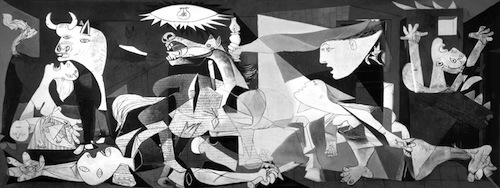To write poetry after Auschwitz is barbaric...Critical intelligence cannot be equal to this challenge as long as it confines itself to self-satisfied contemplation. Theodor W. Adorno, Prisms, 1955
Pablo Picasso painted Guernica in urgent response to the aerial bombing of civilians in a Basque village in northern Spain by German and Italian warplanes during the Spanish Civil War in April 1937. Spain was Picasso's native country; his response to fascist aggression was visceral and intensely personal, beyond even his strongly held political and humanitarian convictions. The painting was completed in one month and exhibited in July 1937 at the Spanish Pavilion of the Paris International Exposition and later in several countries before the start of the Second World War. Because of its extensive reach through widespread exhibition and reproduction in magazines and newspapers, and despite its obscure and overdetermined symbolism, the painting was recognized as a universal and potent emblem of the anguish and devastation of war. This was the last time any painting would have such immediate and widespread impact; paintings don't have anything like that currency anymore.
Pablo Picasso, Guernica, 1937. Oil on canvas. 349 cm × 776 cm. Museo Reina Sofia, Madrid
In 1946, immediately after the war and nine years after painting Guernica, Picasso turned in Joie de Vivre to the light fantasy of frolicking nymphs, satyrs, fauns, and centaurs from classical mythology. Considering the events so acutely evoked and portended in Guernica were horribly and uncontrollably multiplied throughout the world in the years after 1937, Picasso's post-war work looks like escapism, or the "self-satisfied contemplation" the German philosopher Theodor Adorno condemns. Next to Guernica, which galvanized the world, Joie de Vivre might seem a little silly and ineffectual.
Pablo Picasso, La Joie de Vivre, 1946. Ripolin on wallboard. 120 cm x 250 cm. Musée Picasso, Antibes
Could Picasso not again face what humanity had done? Did he recoil at the idea of any aesthetic response to horror and devastation on that scale? Or, in the face of such unimaginable suffering, did he find art unequal to the task? In any event he wasn't in the mood to look at suffering and anguish, and post-war art, with its move towards abstraction, wasn't either.
A little later in life Adorno qualified his earlier statement above and suggested that "The abundance of real suffering permits no forgetting... Suffering... also demands the continued existence of the very art it forbids; hardly anywhere else does suffering still find its own voice." Theodor Adorno, Notes to Literature III, 1962. He reminds us that, in spite of everything, art can inform, shame, and push us to see what we'd prefer to forget.

